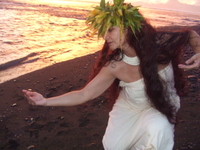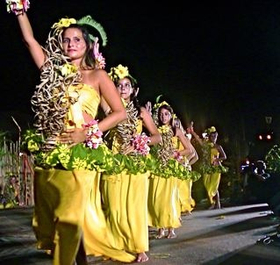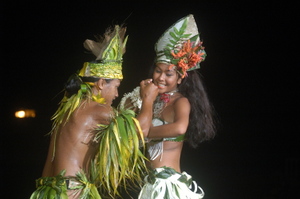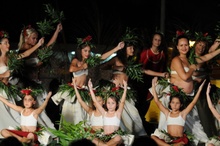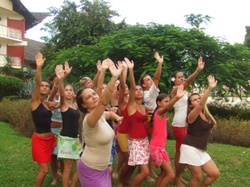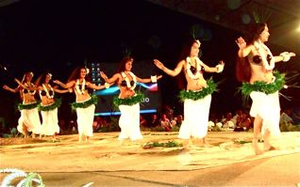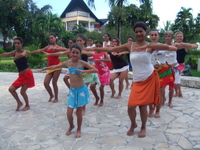Execution basis of Tahitian dance
I have been asked to present the principles of Tahitian dance.
and to explain the bases of execution of Tahitian dance.
As far as I know, it has never been done, at least under this optical. Nothing in Tahitian dance has been codified to this day, even at the conservatory. I have proceeded by analogy with what I know from classic dance principles, which I have been practicing since my childhood and keep practicing the bar.
Generalities
So far, I limit myself to the technical side. The symbolic side also is present but is regularly subjected to controversy because it is mainly related to a re-possession of the past: the first missionaries purely and simply forbade dancing at the beginning of the 19h century. In theory, everything has a signification. In practice, it seems much more prosaic.
With some exceptions, dancing techniques for men and for women are very different. The choreographies lead both of them to join in dancing, or separately, but never with the same movement at the same time. The Duo, or two persons step exists, especially during dance competition.
My responsibilities as choreographer have given me the opportunity to mix groups in dancing. However, I do not teach men and for the time being, the project that I present only concerns female dancing. So I only expose here what is attached to female dancing.
It is the same for Tahitian dance then for all other culture: its techniques represent a way to mark a rythm, a conception of the body in movement that reflects a conception of the universe. But the maohi universe (that means “Polynesian” at the large meaning) is absolutely not synthetically – on the contrary, it is for more analytical. At the level of danced movement, this is shown by a sheer complexity that does not appear on the first sight. Choreographies that pile up steps one on the other on rhythms that can be frenetic.
May be this explains the almost total absence of pedagogy in the teaching of dance. Transmission is generally done by imitation. It is shown, and at best, it is corrected only by saying: it’s wrong, look and follow me. It is rarely explained to the student, but only if she asks for details.
I limit myself here to attempt to describe the execution of two basic movements from which all the other steps come. Then, the steps are multiple from the moment when one acquires the required level. Initiation needs several years of practice and is the privilege of a few, even if dancing is widely practiced for leisure.
Technique
The two basic movements where all basic steps and variants come from are: balancing and rolling. Steps move in every direction. These movements are oscillations and rotations in ellipse around the axel composed by the vertebral spine. They are executed by using the strength of the bodyweight (switch). The trunk never follows the movement of the lower part of the body; it stays free for the execution of the gesture. Gesture and steps are rigorously coordinated.
Traditionally, only gesture expresses the theme of the dance. This rule is however not obligatory, since dancing techniques and choreographic conception have evolved in the last years. In dance contests, steps now have to express the theme.
Standing, foot support, bodyweight switch
Tahitian dance is executed with bent legs, to ensure a good execution of the step; shoulder, hip and ankle have to be vertically lined up. Feet are parallel, apart one from eachother,and joined at the same width as the hips’. Knees have to exactly fall on toes. Concerning flat feet support, the bodyweight is shifted on the outer side of the floor so that knees are not turned inward in an “X” position. some teacher require that the students keep there feet closed and flat on the ground.. The conservatoire does not, and ask the students to lift their heels up and down when dancing.
Inward and outward are not usual concepts in Tahitian dance. I only use them as reference to notions that are familiar. Outward is necessary for some variants. Dancers who do not naturally possess it can never execute it properly
.
Relation to music
Traditional rhythms are binary, of two to four times. Anything that can be heard today that do not follow this rule correspond to an imported element (waltz, 5-time rhythm, ternary rhythm)
To follow, all the techniques of Tahitian dance come from the formula of one-two, or one-two-three, or one-two-three-four. The principles of transfer in space have a very strong link to pulse; even though dancing can be done on rhythm as well as pulse. So in four pulses or four-sub pulses, the hip is balanced four or three times, the fourth time is stopped or corresponds to the stretching of the hip executed in four times.
Choreographies can also be practiced without music, the latest is composed after or from the steps. Dances based on a song or cited text are however, always based on music.
The two basis : balancing, rolling
Balancing : tamau, which means continuous
There are four ways of moving the hips, which subdivide in variants with flat foot or half-raised foot, standing or flexed. The first two variants are executed by the principle of walking: feet and hips impulse the movement; hips following.
• Basic balancing
nº1 – (tamau) the legs adopt a movement of scissor pedaling. The feet stump on the ground. When the step is performed on spot, only talons are slightly lifted. Hips follow the impulse of the legs with a movement of “balance trays”; e.g. in an almost vertical plan. This kind of balancing is the base for all the other steps. If executed improperly all movement will be wrong and most of the steps might not be able to be executed. This is the first lesson. Tamau nº1 is performed flexed or standing, flat feet or half-raised; the step has a different name each time.
• Balancing nº2 (taïri tamau, taïri toma) – the principle is the same. Hips follow legs’ impulse, this time sending the lateral movement as far as possible. This kind of hip moving is the base for other categories of steps.
• Balancing nº3 (tamau tahito –« old » tamau)
This time, the talons stump the ground simultaneously. Hips follow legs’ impulse. This movement uses more particularly the centrifuge strength of the bodyweight.
• Balancing n° 4 ( tamau taere) The principle of execution is the one of “reverse walk”, which means that hip movement is performed without the support of the leg. If moved to the right, bodyweight is slightly shifted on the left foot. Visually, it gives a movement similar so that of the pink panther… This step is very used in Hawaiian dance but is completely part of the techniques of Tahitian dance – which are not very different of our Hawaiian cousins’.
The rolling. It exists several styles of rolling the hip.
The basic principle is close to that of isolating the hips, but the legs command the movement; almost never the hips, with the exception of certain postures that impose to roll with stiff legs.
Globally, there are three ways of rolling which result is different each time: -the faarapu,( that means "to stir") in which the stress of the movement is done with the stomach. The movement is fast and performed on sideway, left or right, depending on the dancer’s leading foot.
- the faarori where the stress of the movement is done with the butt. It is a fast movement performed on one sideway.
- the ami, slow balancing performed sideways which has several variants. It is a wide rolling that obligatory uses the shift of the bodyweight.
Each rolling results of two-combined movement: balancing of the hips and shifting of the basin; reverse of the basin associates breathing, contraction and release of abdominal muscles of lower basin, contraction and release of the perinea.
The standing of the body is indispensable to balance, especially when the step is executed on half-raised foot, joint feet or crossed. The muscles of the butt must never be voluntarily contracted because it will react the speeding. The posture is assured by the trunk (back or rib muscles). Rolling are executed in any positions, standing or flexed, flat foot or half-raised; they move in every direction and superpose to slow steps.

